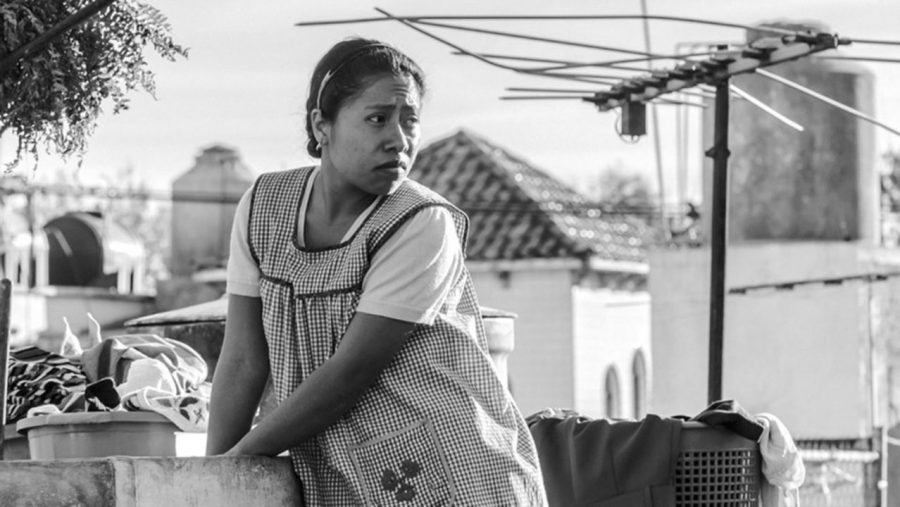Available for streaming on Netflix, Alfonso Cuaron’s latest film “Roma” has received 10 nominations for Oscars 2019.
“Roma” is a work of art that does not aim to entertain its audience, but rather provides an emotional experience through its commitment to realism and truthfulness.
The film captures a year in the life of a maid named Cleo (Yalitza Aparicio) who works for a middle class family in the Roma district of Mexico City from 1970 to 1971. Alfredo Cuaron wrote and directed the film as an autobiography about his childhood with appreciation for his own nanny, the real life Cleo. Though in the film Cleo hardly speaks, her love for the children she cares for, worn resignation toward her social standing and inability to control her difficult situation is expressed through Aparicio’s raw and heartfelt performance.
“Roma” is an enjoyable watch that will enlighten viewers of the cultural and historical roots of modern Mexico. Historical and cultural context is either littered in the backdrop of the film or featured in its most climactic scenes. Cleo hears about land disputes between neighbors when vacationing in the countryside; during this time serfdom was common. “Roma” also criticizes the ties between race and class by showing the social and economic division between Cleo and her peers, who are all indigenous people, and the white middle class who employs them. Later, Cleo becomes a bystander of the Christi Compi Massacre, when paramilitaries disguised as a rival student group attack students protesting in the street below with guns and bamboo sticks. By building the story around these historical happenings, this film evokes empathy for the Mexican people who struggled during this time.
The film delivers its most serious scenes with soulful art and music, even breaking the fourth wall at one point to do so. This tone of romanticism is maintained in the most intense and jarring scenes of the film, and illustrates how meaningful it was for Cuaron to create this film in honor of his past and ancestral history. In a way, this makes the film surreal and makes the viewer feel removed from the story. This is completely intentional, and provides an experience of admiring a beautiful story from afar.
The black and white filter further establishes distance between the story from its audience, as if to be respectful of Cuaron’s memory and the people in his story. Going to the theater is a recurring scene throughout the film, reflecting the filmmaker’s love of movies. In one scene Cleo and the children watch a movie about astronauts, hinting that Cuaron pulled inspiration from his childhood experiences at the theater in making his 2013 movie “Gravity.” Because the story is so personal, people connect with it in ways that cannot be done with most films.
“Roma” transfixes its audience with an alluring naturalism that illuminates both insignificant and dramatic moments without spotlighting anything in particular.
“Roma” transfixes its audience with an alluring naturalism that illuminates both insignificant and dramatic moments without spotlighting anything in particular. At the beginning of the film, there is zero focus on any particular person, both visually and auditorily. Background noise of dogs barking, dishes clanking and side conversations almost distract from the key plot twists. At these points, it seems “Roma”’s pursuit of realism deviates from its ability to fully engage its audience. As the story progresses, the camera’s proximity to the characters increases. As a result, the audience may initially feel as if they are making acquaintances with the characters, but by the end of the film will feel in love with their revelatory experiences and intimately attached to their fate.
Meanwhile, the slow turn of the camera or the lack of movement in many of the shots allow watchers to observe each scene and consider what objects, interactions between characters, and happenings are important. Yet each part of the scene is portrayed with significance, and small details throughout the film offer foreshadowing and symbolism. Every shot is its own masterpiece.


![[PHOTO COURTESY OF IMDB]](https://blueandgoldonline.org/wp-content/uploads/2025/03/IMG_3463-1200x724.jpeg)
![[PHOTO COURTESY OF IMDB]](https://blueandgoldonline.org/wp-content/uploads/2025/03/IMG_3465-1200x831.jpeg)
![[PHOTO COURTESY OF IMDB]](https://blueandgoldonline.org/wp-content/uploads/2025/03/IMG_3462-1200x707.jpeg)
![[PHOTO COURTESY OF IMDB]](https://blueandgoldonline.org/wp-content/uploads/2025/03/IMG_3461-1200x942.jpeg)
![[PHOTO COURTESY OF IMDB]](https://blueandgoldonline.org/wp-content/uploads/2025/01/IMG_2934-1200x511.jpeg)
![[PHOTO COURTESY OF WARNER BROS]](https://blueandgoldonline.org/wp-content/uploads/2025/01/IMG_2933.jpeg)
![[PHOTO COURTESY OF PENGUIN RANDOM HOUSE, PENGUIN BOOKS, PENGUIN BOOKSHOP]](https://blueandgoldonline.org/wp-content/uploads/2025/05/books-1200x675.png)
![A large "Coulda Been Love" sign in front of the show set. [PHOTO COURTESY OF DRUSKI'S COULDA BEEN LOVE SHOW]](https://blueandgoldonline.org/wp-content/uploads/2025/05/IMG_1877-1200x678.jpeg)
![[PHOTO COURTESY OF IMDB]](https://blueandgoldonline.org/wp-content/uploads/2025/05/Untitled-design-2.png)
![[PHOTO COURTESY OF IMDB]](https://blueandgoldonline.org/wp-content/uploads/2025/05/MV5BY2UwOGUxMzEtMzEyZi00NjEwLTkxOTMtYTljOWEzYjYyMWNjXkEyXkFqcGc@._V1_-810x1200.jpg)
![[PHOTO COURTESY OF SPOTIFY]](https://blueandgoldonline.org/wp-content/uploads/2025/03/IMG_3468-1200x594.jpeg)
![Tyler, The Creator, American rapper and record producer, reaches out his hand. [PHOTO COURTESY OF COLUMBIA RECORDS]](https://blueandgoldonline.org/wp-content/uploads/2025/01/IMG_2935.webp)